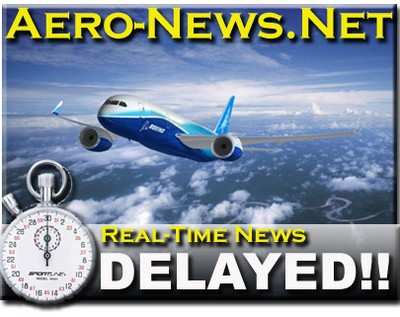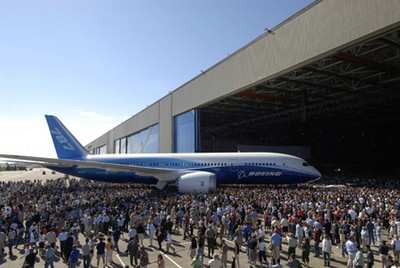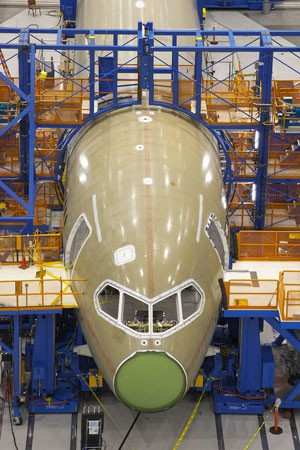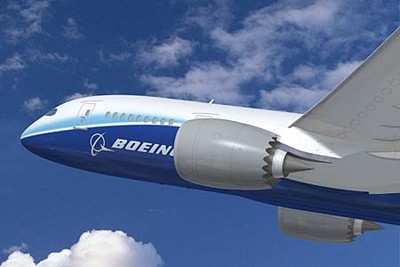First Flight Now Q4 2008; Deliveries In Q3 '09
It's not really unexpected... but it's still a major blow to
Boeing's struggling 787 Dreamliner program. Moments ago, the
American planemaker announced a revised plan for first flight and
initial deliveries of the 787, that moves target dates for those
milestones off by as much as six months beyond earlier
expectations.

While noting significant progress has been made assembling
Airplane #1 -- the aircraft unveiled with great fanfare last July
-- Boeing says first flight is being rescheduled due to slower than
expected completion of work that traveled from supplier facilities
into Boeing's final assembly line, unanticipated rework, and the
addition of margin into the testing schedule.
"The new delivery schedule is based on a more conservative
production plan developed with the 787 partner team," said the
planemaker, which now targets "approximately" 25 deliveries in
2009.
First flight of the composite-bodied airplane will move into the
fourth quarter of this year rather than the end of the second
quarter, and first delivery is now planned for the third quarter of
2009 instead of first quarter.

Despite the ominous nature of Boeing's announcement -- this is
the third time Boeing has been forced to delay the Dreamliner's
progress, due to production-related issues -- company officials
expressed confidence in the new plan and the steps being taken to
accelerate program performance.
 "Over the past few months, we have
taken strong actions to confront and overcome start-up issues on
the program, and we have made solid progress," said Boeing
Commercial Airplanes President and CEO Scott Carson. "Nevertheless,
the traveled work situation and some unanticipated rework have
prevented us from hitting the milestones we laid out in January.
Our revised schedule is built upon an achievable, high-confidence
plan for getting us to our power-on and first-flight milestones.
Also, while the fundamental technologies and design of the 787
remain sound, we have inserted some additional schedule margin for
dealing with other issues we may uncover in testing prior to first
flight and in the flight test program."
"Over the past few months, we have
taken strong actions to confront and overcome start-up issues on
the program, and we have made solid progress," said Boeing
Commercial Airplanes President and CEO Scott Carson. "Nevertheless,
the traveled work situation and some unanticipated rework have
prevented us from hitting the milestones we laid out in January.
Our revised schedule is built upon an achievable, high-confidence
plan for getting us to our power-on and first-flight milestones.
Also, while the fundamental technologies and design of the 787
remain sound, we have inserted some additional schedule margin for
dealing with other issues we may uncover in testing prior to first
flight and in the flight test program."
As ANN reported, the company
said in January it would be conducting a comprehensive assessment
of its supply chain and production system capabilities to determine
the details of the 787's flight test program and initial delivery
profile.
As a result of that assessment, the first-year delivery plan
announced Wednesday will be followed by what Boeing terms "a more
gradual ramp up to full-rate production than previously
planned."
"We deeply regret the disruption and disappointment these
changes will cause for our customers, and we will work closely with
each of them to minimize the impact," said Carson. "We have taken
significant action to improve supply chain and production system
performance, such as our investment in Global Aeronautica, but
based on our assessment, the prudent course is to proceed with a
more gradual ramp up to full-rate production."

Pat Shanahan, 787 vice president and program manager, echoed
Carson's comments about the progress being made in 787
factories.
"The work that remains to be done on Airplane #1 is well
defined, and we can see our way to -- and have confidence in -- the
new milestones we have set for it," said Shanahan. "We have
addressed the major challenges that slowed our progress while
trying to complete the primary structure -- the parts shortages,
engineering changes, and manufacturing changes -- and we are well
into the systems installation that is the precursor to putting
power on the airplane for the first time. We have also worked
closely with our partners to achieve higher levels of completion of
their parts of subsequent airplanes, and we will continue to drive
improvements in the supply chain and production system
performance," he said.
For tracking program progress, Shanahan outlined a series of
milestones that will occur before June 30: 787 static and fatigue
structural test airplanes will move to their testing locations;
Airplanes #3 and #4 will enter final assembly; hardware
airworthiness qualifications will be complete; and power on will be
achieved.
Shanahan also said the program has changed the timing of the
introduction of two 787 derivatives. The 787-9, a larger variant of
the airplane, will be the first derivative of the baseline 787 with
delivery planned for early 2012. The 787-3, a shorter-range model
previously slated to deliver in 2010, will now become the second
derivative of the airplane family.

While research and development costs will likely increase as a
result of the 787 schedule change, Boeing says it expects no change
to 2008 earnings guidance.
 Aero-News: Quote of the Day (04.28.25)
Aero-News: Quote of the Day (04.28.25) ANN's Daily Aero-Term (04.28.25): Decision Altitude (DA)
ANN's Daily Aero-Term (04.28.25): Decision Altitude (DA) ANN's Daily Aero-Linx (04.28.25)
ANN's Daily Aero-Linx (04.28.25) Airborne-Flight Training 04.24.25: GA Refocused, Seminole/Epic, WestJet v TFWP
Airborne-Flight Training 04.24.25: GA Refocused, Seminole/Epic, WestJet v TFWP Aero-News: Quote of the Day (04.29.25)
Aero-News: Quote of the Day (04.29.25)







